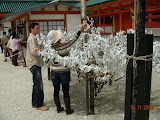4/15/2008
Most all of us made it back to the ship on time, and we are now on a 9 day journey to Honolulu. (There are rumours that we have lost several students throughout the voyage due to alcohol poisoning – another one had to be hospitalized in Kobe - once they recover they are not invited to return to the ship.) We also had a student who lost his passport, so could not get back on the ship. He left his knapsack, with wallet, passport and expensive camera in a restaurant, and by the time he noticed its absence, the restaurant was closed. He went the next morning to the American Embassy in Osaka to report the loss – the knapsack and all its contents had already been turned in. The official assured him that this was the norm in Japan – crime is just not an issue. He will catch up with us in Honolulu.
We crossed the International Date Line on Tuesday April 15th, so the following day was also Tuesday, April 15th – sort of like the movie Groundhog Day, it was so nice, we did twice! Remembering that this is Tax Day in the US, we might want to consider always doing it twice to give those last minute procrastinators one more chance to pay their respects to Uncle Sam!
We have been one day ahead of you for quite some time, so now I think we’re back on the same schedule. We’ll continue to reset the clocks and lose an hour of sleep every day until we reach Hawaii.
Whoever named this the Pacific (peaceful) Ocean had a good sense of humor – it’s been rocking and rolling on board since we set off. At dinner, the food sloshed all over, the cabinets opened and all the cups fell out, and some of the diners ended up on the floor!
4/18
Today was a free day – no classes – so Jim held an all-day meditation retreat on board for his daily meditation group. We started at 09:00, and alternatingly sat, walked, and chanted until 17:00, including a silent lunch and hot tea breaks in the Vipassina Buddhist tradition. We had about 10 students, many staying for the whole experience, and a few coming by for just part of the day to see what it was all about. A quiet time was had by all.

4/19
Today was Crew Appreciation day, so I will tell you a Customer Service story. We have almost 200 crew members on board – room stewards, waiters, busboys, cooks, spa attendants, sailors and officers. They are hired in the Philippines on an 8 month contract, which means they will complete at least two back-to-back semester tours before getting time off to go home.
Mezraim Josephs is a waiter from Jamaica. He works in the Dining Hall, attending to the needs of 700 teenagers (think school cafeteria to a power of 10 – yuck!). He started learning our names on the very first day of the voyage, and greets everyone with a smile in his lilting Bahamian accent – “Good morning to you Mr. Jim, greetings Lady Karen!” He meets us at the buffet and insists on carrying our trays for us – “here is a nice table for you, right by the window the way you like!” or “Ms. Nancy is eating alone this morning, would you like to join her?”

He learned what we like, “two coffee with cream, am I right?”, and then went above and beyond, “I heated up the cream so your coffee will be nice and hot”. He sings to us, sometimes songs that we know, and sometimes songs that he makes up for the occasion. He is always gracious, upbeat and totally attentive to the needs of every person with whom he comes into contact.
Now, Mezraim is no longer young, a bit grey at the temples, and has overcome physical problems – he walks with a slight limp and wears one built-up shoe. His wife, grown children and grandchildren are home in Jamaica where he cannot see them for eight months. He has had his share of trouble; one son on drugs, grandbabies to raise, yet he smiles. Yet he sings.
One morning I asked the meaning of his name Mezraim. He said it was from the Bible, but he really didn’t know where. Me being me, I logged onto the computer right after breakfast, and Googled “Mezraim”, expecting the biblical reference to come up and point me in the right direction. Imagine my surprise when practically the whole first page of citations were for “Mezraim on Semester at Sea”. I opened each link to read the blogs of current and former voyagers, extolling the virtues of Mezraim Josephs – how he helps the kids who were homesick, how he reminds them of father, uncle, friend, how he takes such good care them, warms their hearts and makes sure they are doing all right.
I did find the biblical reference after a while – Mezraim was the son of Ham, grandson of Noah in Genesis. He is credited with bringing chemistry to Egypt. I brought this info back to Mezraim the next morning, along with the news that he was famous in the blogs of the students. This brought a tear to his eye – he had no idea that he was so highly regarded, but he was happy to know that the students understood how much he cared.
So, who makes your day? Who makes you smile? Who sees the extraordinary in the ordinary? Appreciate them. Thank you Mezraim!










































